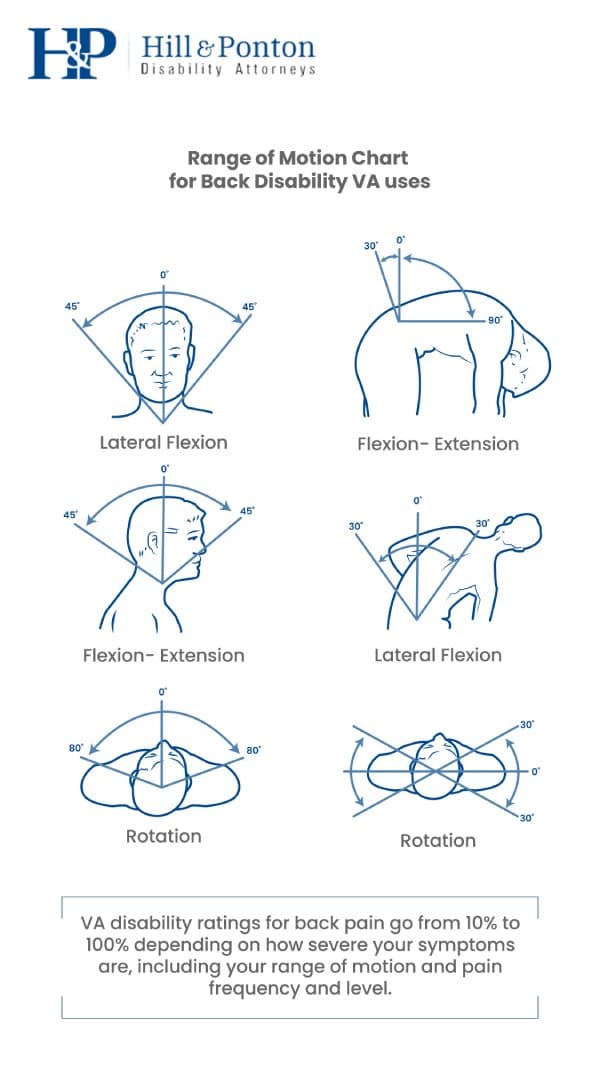Back injuries and spinal conditions are among the most common health issues in veterans, warranting VA ratings from 0% to 100%, and further impacting veterans’ mental health, employment and quality of life. Hill & Ponton helps veterans understand eligibility criteria, how to establish service connection, meet the VA requirements for a successful claim, and secure the highest possible compensation, not just for the back pain but for all its complications.
Back Injuries and Spinal Conditions in the Military
Low back pain and other back problems are the most common reason for active duty service members to seek medical care, with Army personnel reporting the most back-related injuries according to a 2024 study. This is largely due to the physically demanding nature of their duties, which involve repeated lifting, impact activities, and sustained wear on the spine.
- Army: The highest rates of service-connected back pain, especially among infantry, airborne, and combat support personnel.
- Marines: Also reporting elevated rates of spinal injuries due to intense physical training and combat operations.
- Navy and Air Force: Lower rates compared to the Army and Marines, but aviation-related spinal strain and shipboard labor can still result in serious back issues.
High-Risk Military Occupations
Certain military jobs place service members at a greater risk of developing acute or chronic back pain, often due to repetitive physical strain and the need to operate in high-impact environments. High-risk roles include:
- Infantry and ground combat troops (heavy gear, repeated impact)
- Paratroopers (spinal compression from jump landings)
- Combat engineers (manual labor with explosive and mechanical equipment)
- Vehicle operators and loaders (jarring motion and heavy lifting)
- Special operations forces (high-speed movement with tactical gear)
- Pilots and aviation crew (neck and back strain from G-forces and seating posture)
- Medical personnel and logistics (frequent lifting of patients, equipment, or cargo)
These occupations frequently involve carrying heavy gear (often exceeding 80 pounds), repeated jumping or landing (e.g., from aircraft), operating machinery, loading/unloading cargo, and enduring prolonged postures. Over time, these demands can lead to muscular strain, vertebral compression, disc degeneration, and nerve impingement affecting the cervical, thoracic, or lumbar spine.
What Exactly Causes Back Pain in Service Members?
- Repetitive Physical Stress: The constant lifting, rucking, crawling, and jumping required in military life places ongoing stress on the lower back and the entire spine.
- Cumulative Load Bearing: Wearing body armor, helmets, rucksacks, and other load-bearing gear daily compresses the spine and accelerates joint and disc wear.
- Improper Lifting Techniques: In combat or high-tempo environments, lifting heavy items under pressure and without proper form increases injury risk.
- High-Impact Activities: Activities such as parachute jumps, breaching drills, hand-to-hand combat, and convoys over rough terrain all place extreme shock loads on the spine.
- Reduced Recovery Time: Service members often continue working through pain, and intense training cycles don’t allow for sufficient recovery, leading to chronic injury buildup.
- Pre-existing or Undiagnosed Conditions: Undetected scoliosis, previous injuries, or spinal alignment issues can be aggravated during service, especially under load.
- Psychological and Physical Stress: Chronic stress, fatigue, and mental strain can intensify the experience of physical pain and contribute to long-term musculoskeletal dysfunction.
How Does the VA Rate Back Pain?
Back pain is rated from 0% to 100%, based on the impact it has on overall physical wellbeing and the capacity to engage in daily activities. The VA assesses how back pain restricts movement and interacts with day-to-day life, utilizing a detailed ratings system, specifically for musculoskeletal disabilities.
While certain spinal conditions have their own rating criteria, the VA’s General Rating Formula for Diseases and Injuries of the Spine uses “favorable” and “unfavorable” ankylosis to describe the mobility or immobility of the spine. In simpler terms, “ankylosis” refers to the extent of movement your spine can achieve. A “favorable” designation means the spine maintains a straight posture, whereas “unfavorable” ankylosis indicates a spine that is fixed in a bent position, severely limiting mobility.
The Range of Motion (ROM) Chart

Ratings hinge on Range of Motion measurements, which are done with a goniometer – a specialized tool used to measure how far you can move in each direction:
- Flexion (bending forward)
- Extension (bending backward)
- Lateral flexion (side bending)
- Rotation
The measurements must be taken three times and averaged. Examiners must assess pain on motion, weakness, fatigability, flare-ups, and incoordination. They must also identify whether there is functional loss due to pain, and if the condition worsens with repetitive use over time. Each area is evaluated separately to determine its impact on mobility and daily life.
VA Ratings for Thoracolumbar Spine Injuries
- 100% rating: Unfavorable ankylosis of the entire spine, including the neck. Unfavorable ankylosis is defined by the VA as a condition where the spine is fixed in flexion or extension and results in one or more of the following: difficulty walking because of a limited line of vision; restricted opening of the mouth and chewing; breathing limited to diaphragmatic respiration; gastrointestinal symptoms due to pressure of the costal margin on the abdomen; dyspnea or dysphagia; atlantoaxial or cervical subluxation or dislocation; or neurologic symptoms due to nerve root stretching.
- 50% rating: Unfavorable ankylosis of the entire thoracolumbar spine.
- 40% rating: Forward flexion of the thoracolumbar spine is 30 degrees or less, or there is favorable ankylosis (immobility) of the entire thoracolumbar spine.
- 20% rating: Forward flexion of the thoracolumbar spine is greater than 30 degrees but not greater than 60 degrees, or the entire thoracolumbar spine is limited to 120 degrees or less.
- 10% rating: Forward flexion of the thoracolumbar spine is greater than 60 degrees but not greater than 85 degrees, or there is muscle spasm, guarding, or localized tenderness without abnormal gait or spinal contour.
VA Ratings for Cervical Spine Injuries
- 40% rating: Unfavorable ankylosis of the entire cervical spine.
- 30% rating: Forward flexion of the cervical spine 15 degrees or less, or favorable ankylosis of the entire cervical spine.
- 20% rating: Forward flexion of the cervical spine greater than 15 degrees but not greater than 30 degrees; or the combined range of motion of the cervical spine not greater than 170 degrees.
- 10% rating: Forward flexion of the cervical spine greater than 30 degrees but not greater than 40 degrees; or combined range of motion of the cervical spine greater than 170 degrees but not greater than 335 degrees.
VA Ratings for Intervertebral Disc Syndrome
Intervertebral Disc Syndrome (IVDS) involves the degeneration, herniation, or other damage to the spinal discs that cushion the vertebrae. It can be rated in two ways, whichever results in the higher disability rating: under the General Rating Formula for Diseases and Injuries of the Spine (based on limitation of motion, pain, and functional impairment) or according to the Formula for Rating Intervertebral Disc Syndrome Based on Incapacitating Episodes, which evaluates the total duration of doctor-prescribed bed rest (incapacitating episodes).
- 60% rating: Given for incapacitating episodes totaling 6 weeks or more within the past 12 months.
- 40% rating: Assigned when incapacitating episodes occur for at least 4 weeks but less than 6 weeks during the past 12 months.
- 20% rating: For incapacitating episodes lasting at least 2 weeks and less than 4 weeks during the past 12 months.
- 10% rating: For incapacitating episodes having a total duration of at least 1 week but less than 2 weeks during the past 12 months.
What Is the Average VA Disability Rating for Back Pain?
The average VA disability rating for back pain is between 10–30%, typically falling around 20%. This is because many veterans experience a range of motion limitations and pain that are significant enough to warrant a rating higher than 10% but not severe enough to meet the criteria for higher ratings like 40% or 50%.
For conditions like lumbosacral or cervical strain, degenerative disc disease, or intervertebral disc syndrome, the 20% rating is often the most common because it reflects moderate impairment and limitations in the range of motion, which are frequently encountered by veterans with these conditions.
However, many veterans are underrated. It is important to ensure that all symptoms, including neurological complications and functional loss, are fully documented. If you were underrated, get a free evaluation of your claim to explore your options.
Maximize Your Benefits
Unhappy with your VA decision? We’re here to help. Contact us for a free review of your case.
How To Get Up to 100% VA Disability
If you’re like many veterans, you may have a debilitating spinal injury without being immobilized (to obtain a 100% VA disability rating for a back condition on its own, there must be a total immobilization of the spine, where both the thoracolumbar and cervical areas show no mobility). But you still have other options for a higher disability rating, even 100%.
You can appeal for a rating increase if you’ve been underrated, connect your back pain to a secondary condition for a combined rating, and, if you are unable to maintain substantially gainful employment (earning above poverty level), apply for TDIU which pays the equivalent of a 100% rating. Get a free case evaluation and we’ll point you in the right direction.
Connecting Secondary Conditions to Back Injuries
Back injuries often trigger additional health issues, which may contribute to a higher combined disability rating. Veterans can connect multiple conditions, so consider how your back pain impacts other aspects of your life and well-being. Common secondary conditions include:
- Radiculopathy: Characterized by nerve pain, numbness, or tingling that radiates from the spine to the extremities. Depending on the affected area, it can manifest as nerve pain in the legs (from lower back issues) or arm pain (from neck issues).
- Osteoarthritis: Stiffness and joint pain resulting from the degeneration of cartilage, which can be secondary to changes in posture and walking due to spinal injuries.
- Spinal Stenosis: Narrowing of the spinal canal, often leading to nerve pain and mobility issues. This can be a direct consequence of spinal injuries or degenerative changes over time.
- Spondylolisthesis: A condition where one vertebra slips forward over another, often resulting from injury or degeneration, leading to back pain, numbness, or weakness.
- Traumatic Paralysis: Paralysis resulting from a traumatic injury to the spinal cord, leading to partial or complete loss of muscle function and sensation below the level of injury. This condition significantly impacts daily living and may require comprehensive medical and support services.
- Chronic Pain Syndrome: Persistent pain that can develop following spinal injuries, affecting physical and mental health.
- Depression and Anxiety: Mental health conditions that can arise due to chronic pain, reduced mobility, and the lifestyle changes that spinal injuries often necessitate.
- Impaired Mobility: Limitations in movement and activities of daily living due to pain, stiffness, or loss of function in the spine.
- Orthopedic Problems in Knees and Hips: Issues arising from altered walking patterns due to spinal injuries or conditions, which can lead to additional strain and injuries in the knees and hips.
- Urinary or Bowel Incontinence: Nerve damage from spinal injuries can lead to issues with bladder or bowel control.
- Sexual Dysfunction: Spinal injuries can affect sexual health and function due to nerve damage or psychological stress related to the injury and its implications.
Why Worry About All the VA’s Complicated Tables When We’ve Done the Work for You?
Navigating the VA’s complex disability rating tables to figure out multiple ratings can be overwhelming and confusing. That’s where the VA Disability Calculator comes in – a tool specifically designed to save you time and effort! With just a few clicks, you can gain insights into:
- Your Expected Disability Rating: No more guessing or trying to interpret complicated tables. The Hill & Ponton calculator provides a clear estimation of the rating percentage for your specific back condition or combined conditions.
- Your Potential Compensation: Understand the financial support you might be eligible for. The calculator breaks down the compensation tied to various disability ratings, giving you a clear picture of your potential benefits.

TDIU for Back Pain That Prevents Working
If back pain significantly impairs your ability to work, Total Disability based on Individual Unemployability can provide compensation at the 100% rate, even if the direct disability rating is lower. TDIU is applicable for veterans whose back pain doesn’t allow stable employment that earns above poverty level, offering a lifeline for those unable to maintain regular work due to their condition.
Schedular vs. Extraschedular Individual Unemployability
According to VA regulations, schedular Individual Unemployability (TDIU) is available when a veteran has either a single service-connected disability rated at 60% or higher, OR a combined rating of 70%, with one condition rated at least 40%.
Back conditions like degenerative disc disease (DDD), intervertebral disc syndrome (IVDS), spinal stenosis, and spondylolisthesis are commonly rated at 40%, 50%, or even 60%, particularly when they involve severe range of motion limitations or frequent incapacitating episodes. Many veterans also have secondary conditions like radiculopathy, depression, or knee and hip problems that can meet the schedular TDIU criteria when combined with a back disability.
But even a single service-connected back condition, if well-supported with medical evidence and impact on employment, can form the basis for a successful TDIU claim. Get Help from a TDIU Lawyer →
Extraschedular Individual Unemployability
If you don’t meet the standard schedular thresholds, but your back condition severely limits your ability to work, you may still qualify for extraschedular TDIU under 38 C.F.R. § 4.16(b)). Veterans frequently awarded extraschedular TDIU for back disabilities show symptoms like:
- Inability to sit or stand for extended periods
- Chronic pain requiring medication or assistive devices
- Limited ability to lift, carry, or bend
- Unreliable attendance or concentration due to pain or flare-ups
How Hill & Ponton Won an Extraschedular TDIU Claim
In an appeal from the VA Regional Office of Columbia, South Carolina, handled by attorney Matthew Hill, the Board of Veterans’ Appeals reviewed the case of a veteran who served from August 1977 to August 1979. Prior to November 16, 2009, the veteran had a combined disability rating of 40% for multiple service-connected conditions, including degenerative disc disease of the lumbar spine (20%), bilateral lower extremity radiculopathy (10% each side), and bilateral pes planus (0%). This was insufficient under schedular criteria for TDIU.
The veteran worked until undergoing lumbar fusion surgery in August 2003, after which he experienced increased pain, weakness, and numbness. He did not return to work and remained unemployed. However, the Director of Compensation Service denied extraschedular TDIU for the period before November 2009, in spite of the medical evidence.
Hill & Ponton used private physician statements, VA examinations, and a vocational expert report to prove that the veteran was unemployable since August 2003, due to his service-connected conditions. The Board of Veterans’ Appeals decision No. 1711810 from April 12, 2017 granted the veteran TDIU on an extraschedular basis under 38 C.F.R. § 4.16(b), retroactive to August 13, 2003.
Special Monthly Compensation for Back Disabilities
Special Monthly Compensation is an additional VA benefit paid on top of a veteran’s regular disability compensation when their service-connected conditions result in severe impairment or exceptional circumstances beyond what the standard ratings cover. Veterans with spinal cord injuries or back disabilities qualify for SMC if their condition causes significant loss of mobility, independence, or bodily function.
SMC for Being Housebound (SMC-S)
Veterans can get housebound status if the back condition leaves them largely confined to the home or immediate surroundings due to pain, immobility, or the need for assistive devices. To qualify, they must either:
- Have one service-connected disability rated at 100% (such as complete spinal ankylosis or paralysis), and additional disabilities rated at a combined 60%, or
- Be “substantially confined” to their home because of back disability and related conditions.
For example, a veteran with a 100% rating for severe lumbar and cervical spine fusion and an additional 60% combined rating for radiculopathy and depression secondary to pain may qualify for SMC-S under 38 U.S.C. § 1114(s).
Aid and Attendance (SMC-L through SMC-R)
Veterans whose spinal or back disabilities are so severe that they require regular assistance with activities of daily living may qualify for Aid and Attendance if they:
- Cannot bathe, dress, or feed themselves without help
- Need assistance adjusting braces or prosthetic devices
- Require another person to use the toilet or move safely
- Are bedridden due to their condition
Back and spinal disorders that result in partial or total paralysis, chronic pain with immobility, or neurogenic bowel or bladder are common bases for A&A. Veterans who rely on a caregiver or spouse for daily support often qualify for this higher level of SMC.
SMC for Loss of Use of Extremities or Bodily Function
Severe spinal conditions can lead to “loss of use” of a body part or function. This means the limb or function is no longer effective for everyday activity, even if it is not fully amputated or paralyzed. This includes:
- Cannot bathe, dress, or feed themselves without help
- Need assistance adjusting braces or prosthetic devices
- Require another person to use the toilet or move safely
- Are bedridden due to their condition
Frequently Asked Questions
Service connection means the VA recognizes your back condition was caused or aggravated by your military service. Once established, it makes you eligible for monthly disability compensation and other benefits.
You’ll need three elements: 1) A current diagnosis for a back condition; 2) Evidence of an in-service event, injury, or exposure; 3) A medical nexus linking the condition to service (this can come from the VA or private doctors). Find out more about establishing service connection.
Yes. You are eligible for service connection based on aggravation if your military duties permanently worsened a pre-existing condition. You’ll need medical evidence showing the progression and lack of natural worsening.
You can still win VA disability for chronic back pain even without military medical records by providing alternative forms of credible evidence. Submit a personal statement explaining how and when the back pain began, the likely cause (such as heavy lifting, physical training, or injury during service), and why you didn’t seek treatment at the time, plus statements from others who witnessed your symptoms during or shortly after service. Include post-service medical records showing a current diagnosis and a long-standing history of back issues, as well as a medical opinion (nexus letter) from a doctor stating it is “at least as likely as not” that the back disability is related to your military service.
Yes. The VA is required to assist in developing your claim, including obtaining military records, treatment notes, and ordering a Compensation & Pension (C&P) exam when needed.
While it can be harder, many veterans win their claims by showing chronicity and continuity of symptoms, even without immediate post-service records. You can prove continuity of symptoms after separation by providing documentation of consistent treatment (even if it started years later), lay statements from family, friends, or employers noting physical limitations, and a timeline of your pain and treatment history in your own words.
You have 3 appeal options: Supplemental Claim if you have new evidence, Higher-Level Review, or a Board of Veterans Appeal. A Hill & Ponton VA disability lawyer can help you choose the best path for your specific situation.




